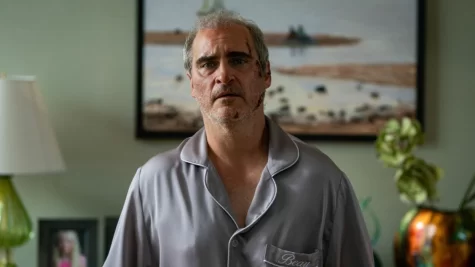REVIEW: ‘Beau Is Afraid’ is a visually stunning, anxiety-fueled odyssey
Ari Aster’s third theatrical release, “Beau Is Afraid,” is undoubtedly his most daunting from a viewer’s perspective. It is a three-hour display of Murphy’s Law, where everything that can go wrong does go wrong. While Aster’s first two films “Hereditary” (2018) and “Midsommar” (2019) were certainly horror films, “Beau Is Afraid” is equal parts comedy, drama and horror. With each unfolding of events, the number of possible interpretations of the story grows as the lines blur between reality, dreams, nightmares and hallucinations.
The film follows Beau Wasserman (Joaquin Phoenix) as he tries to travel from his small apartment in a dangerous part of a big city to his mother’s suburban home. While he acts like his relationship with his mother is healthy, a moment with his therapist reveals that they carry tension. He oversleeps the day of his flight and is in a rush to get to the airport. He is walking out the door when he goes back into his apartment to retrieve an item he forgot. When he returns to the hallway, his suitcase and his keys are missing. Not wanting to leave his apartment open to the public, he is forced to miss his flight to the disappointment of his mother. Now, he must find another way to get to his mother’s house.
While sometimes complicated, “Beau Is Afraid” tells a simple story. An extremely anxious man faces internal and external obstacles as he travels to his mom’s house. When these obstacles appear, they reveal how Beau tackles adversity, and it shows the struggle that high anxiety individuals go through to complete relatively simple tasks. Ari Aster builds a nightmare world destined to make viewers empathize with Beau and even see the brighter side of the world they live in.
Throughout this three-hour odyssey, Beau faces obstacle after obstacle. Most, if not all, of the film is from his perspective, so everything shown on screen is subjective. Because of this, even with a hyper-focused analysis of the film, viewers will still question the full timeline of events. This is clear from the very beginning as it is uncertain whether someone stole his keys and suitcase or whether his nervousness about visiting his mom is causing him to create scenarios where it is impossible to get there.

The film’s one major hinderance is that, from the beginning, its style of storytelling will either click with viewers and provide a unique experience or fall short and seem gimmicky. If the latter occurs, what follows is three hours of confusion, making the story feel incomplete. However, if viewers take the former as their lens with which they view this film, they will be treated to a beautifully directed unorthodox take on the hero’s journey. Through the nightmares and the false memories, viewers will have uninhibited access to Beau’s deepest and darkest fears as they see the past, present and future through his eyes.
Simply put, the unique structure and Beau’s story are a perfect blend for someone like Ari Aster to showcase.
As mentioned, Ari Aster’s direction is phenomenal, a trend that was set with his first two films. In each of his films, every frame is pieced together with so much precision, every shot is appropriately timed, and it is a perfect example of everything onscreen having purpose. Much of that is owed to the production design as well as every set piece, prop and artifact, which each have reasoning and intention behind their placement. Because of the film’s many details, Aster had to do a lot of directing to make sure no detail was missed on screen. Often, “a lot of directing” and “good direction” are used interchangeably, although very different in context. In this case, Aster is able to accomplish both.
The performances make up so much of the weirdness of the film. Phoenix is no stranger to critical acclaim for his acting, but if there is one film that really shows his range, it is this one. Phoenix portrays Beau with what seems like every emotion there is. He shows contempt, confusion, anxiousness, fear, joy, contentment and anger as well as any number of combinations.

The supporting performances are no less spectacular. Along the way, Beau takes time to recover in a suburban home with Grace (Amy Ryan) and Roger (Nathan Lane) and their teenage daughter Toni (Kylie Rogers). Through this whole act, strange happenings accompany Beau’s stay at their house. This is felt through Ryan and Lane’s abilities to be comforting pseudo-parents to Beau while imposing latent intimidation tactics to ensure Beau stays in line with what they want. Kylie Rogers is undoubtedly the scene-stealer in this act as Toni, an angry teenager that resents her parents for neglecting her in favor of Beau. Without spoiling the end of this act, Rogers transforms into everyone’s worst nightmare of a teenage girl as she manipulates and terrorizes Beau during his stay.
At points in the movie, we see portrayals of Beau’s mom Mona played prominently by Pattie LuPone. Through these scenes, viewers witness Mona’s interaction with her son, and these insights into their relationship give the audience the context required to understand Beau’s anxiety. LuPone’s performance is similar to Rogers in their display of contempt and frustration with how Beau has affected their lives. However, her performance is different in that she must deliver her lines with anger for how Beau has treated her while still coming from a place of love. She does this with ease, and it makes Mona the scariest character of the film.
There is one extremely creative scene that encapsulates the film’s nature. To remain fully unspoiled, skip to the next paragraph. At one point, Beau is watching a theater production and starts to see himself as the play’s protagonist. As he becomes this character, his surroundings also morph into scenery made of cardboard and paint. A fantastical few minutes follow as a recap of the play’s protagonist’s life occurs around Beau, which slowly turns into a look into the future as the scenery darkens and the events become more unfortunate.
The foreshadowing in this scene creates a question in the viewer’s mind whether the events of the film will follow the same path. It is a scene where viewers must accept the unusual mix of animated and live-action filmmaking and focus on what the scene is saying. In the same way, viewers must get used to the point of view used in this film and focus on how Beau tackles returning home to face his relationship with his mother.
Ari Aster is one of Hollywood’s most exciting up-and-coming filmmakers. “Beau Is Afraid” showcases that he can stick to his unsettling roots while introducing high levels of comedy and adventure. With this newfound range of storytelling, it’s hard to know what he’ll do next. One thing’s for sure, though—fans have every reason to be excited for future Ari Aster projects.








